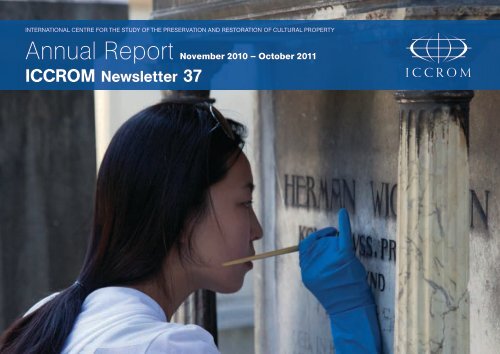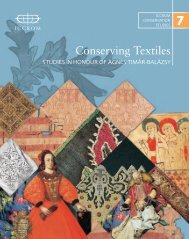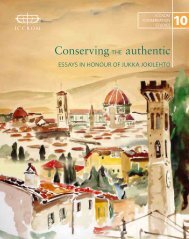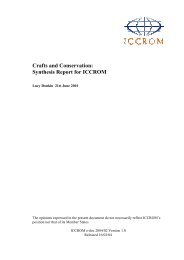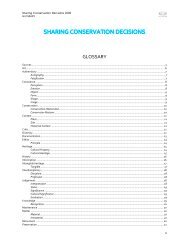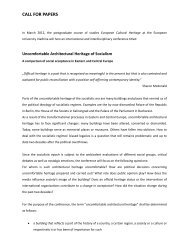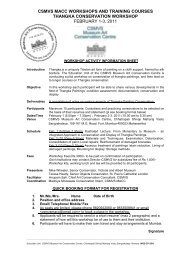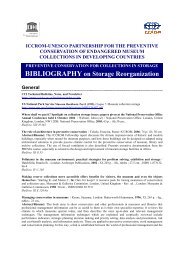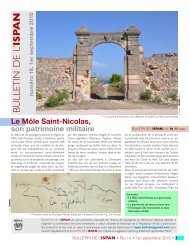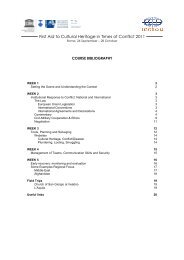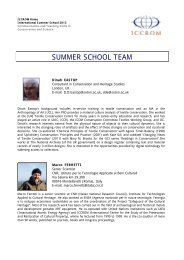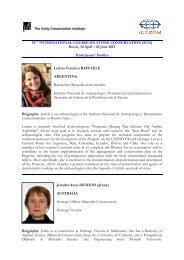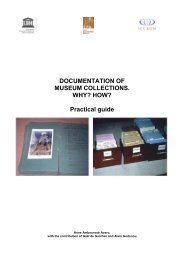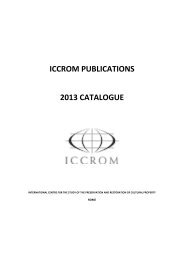Annual Report 2011 - Iccrom
Annual Report 2011 - Iccrom
Annual Report 2011 - Iccrom
You also want an ePaper? Increase the reach of your titles
YUMPU automatically turns print PDFs into web optimized ePapers that Google loves.
INTERNATIONAL CENTRE FOR THE STUDY OF THE PRESERVATION AND RESTORATION OF CULTURAL PROPERTY<br />
<strong>Annual</strong> <strong>Report</strong> November 2010 – October <strong>2011</strong><br />
ICCROM Newsletter 37
Contents<br />
Director-General’s Message<br />
1 Director-General’s Message<br />
2 ICCROM at a Glance 2010–<strong>2011</strong><br />
4 ICCROM News<br />
6 Training: international courses<br />
15 Training: regional activities<br />
19 Research and Development<br />
24 Cooperation and Advice<br />
26 Knowledge and Communication<br />
28 Financial Information<br />
T<br />
his year has been busy for<br />
ICCROM as we successfully<br />
complete the biennial<br />
Programme and Budget approved<br />
by the Council and General<br />
Assembly in 2009. In particular,<br />
the ICCROM headquarters in<br />
Rome has been the scene of an<br />
extraordinary variety of activities.<br />
Beyond the usual buzz of groups<br />
of conservators and restorers,<br />
Member State delegations,<br />
partners meetings, and visiting<br />
researchers, the building resonated<br />
with discussions and interactions<br />
of course participants and<br />
teachers from all over the world.<br />
For the first time, the International<br />
Course on Stone Conservation<br />
was held in Rome. Participants<br />
of this course were able to take<br />
advantage of facilities such as<br />
the ICCROM Laboratory and<br />
Library, and over 2000 years of<br />
the city’s material history. ICCROM<br />
headquarters also provided<br />
a neutral setting for heritage<br />
professionals to discuss and debate<br />
First Aid to Cultural Heritage in<br />
Times of Conflict. For ICCROM,<br />
this international course offered<br />
a unique opportunity to engage<br />
and collaborate with other actors,<br />
such as humanitarian organizations<br />
and other institutions at the front<br />
lines of conflict situations. While<br />
these activities took place in Rome,<br />
heritage institutions in ten different<br />
countries in Europe, Asia, Latin<br />
America, and the Arab States also<br />
generously hosted or co-organized<br />
other ICCROM courses on a variety<br />
of issues, from conservation of<br />
modern architecture, to sound<br />
and image collections, and the<br />
monitoring and management of<br />
World heritage properties.
This year, ICCROM explored topics<br />
and trends that are taking shape in<br />
the conservation world. The CollAsia<br />
programme devised two innovative<br />
courses: one on intangible heritage<br />
and the other on climate change, both<br />
in relation to collections in Southeast<br />
Asia. The ATHAR programme in the<br />
Arab States integrated both movable<br />
and immovable heritage within a<br />
single course on the conservation<br />
of organic materials. The LATAM<br />
programme participated in the<br />
organization of a seminar in Brazil on<br />
the increasingly mainstream concept<br />
of performance indicators in cultural<br />
heritage.<br />
Furthermore, this year was extremely<br />
productive for ICCROM training<br />
strategies, with research and<br />
experience being put towards<br />
developing new educational tools.<br />
Breaking from our face-to-face<br />
training approach, the sixth session of<br />
Reducing Risks to Cultural Heritage<br />
became an online course, allowing<br />
for wider participation and deeper<br />
knowledge-sharing over a longer<br />
period of time. On a different note,<br />
ICCROM and UNESCO produced<br />
RE-ORG, an accessible and userfriendly<br />
online tool to guide smaller<br />
museums worldwide in reorganizing<br />
their storage and documentation.<br />
ICCROM also developed a new World<br />
Heritage Capacity Building Strategy in<br />
partnership with IUCN, ICOMOS, the<br />
UNESCO World Heritage Centre, and<br />
other capacity building partners.<br />
As the contribution of other<br />
organizations in providing mid-career<br />
training has become crucial for<br />
meeting the growing needs of the<br />
community, ICCROM actively supports<br />
the initiatives of regional centres.<br />
These include the UNESCO Category<br />
2 Centres in China, South Africa,<br />
Bahrain, Brazil, and Mexico, as well<br />
as the Nara Office of the Asia-Pacific<br />
Cultural Centre for UNESCO (ACCU)<br />
in Japan, the Ecole du Patrimoine<br />
Africain (EPA) in Benin, and the<br />
Centre for Heritage Development<br />
in Africa (CHDA) in Kenya. Also this<br />
year, ICCROM collaborated with<br />
the government of Sharjah in the<br />
establishment of a regional centre in<br />
the United Arab Emirates.<br />
Like many other institutions, we<br />
have faced the challenge of financial<br />
constraints and staff cuts. This has led<br />
to a structural reorganization, merging<br />
the Library, Archives, and Office of<br />
Communication and Information<br />
into a single unit called Knowledge<br />
and Communication Services. As<br />
a result, some of our services have<br />
been inevitably reduced, but this<br />
realignment has also streamlined our<br />
activities and permitted a shift towards<br />
new methods of communication and<br />
access. As of 2010, the annual report<br />
is primarily an online publication, and<br />
this has been met by our readers with<br />
enthusiasm. As we have begun to rely<br />
increasingly on online communication,<br />
we have noted a marked increase<br />
in visits to the ICCROM website and<br />
social media pages. Regarding print<br />
publications, a major achievement<br />
of <strong>2011</strong> has been the production of<br />
the latest volume in the ICCROM<br />
Conservation Studies series on the<br />
history of ICCROM. It was printed<br />
thanks to the generosity of the State<br />
Administration of Cultural Heritage<br />
(SACH) in China and will also be<br />
available in PDF in 2012. At the same<br />
time, the Library and Archives have<br />
undergone system upgrades onto<br />
open source software, improving<br />
search capabilities for users and<br />
enabling our services to work more<br />
efficiently. As we move into the<br />
next biennium, the Knowledge<br />
and Communication Services will<br />
continue its activities to diversify and<br />
expand access to our information and<br />
services.<br />
Since this is the last time that I will<br />
have the privilege of writing the<br />
introduction to ICCROM’s annual<br />
report, I wish to take this opportunity<br />
to commend the hard work, the high<br />
commitment, and the spirit of the<br />
ICCROM team. It is also important<br />
to highlight that the implementation<br />
of the Programme and Budget<br />
has been possible thanks to the<br />
support of our Member States and<br />
partners. Special thanks also go to<br />
the governments of France, Italy,<br />
Japan, Republic of Korea, Sharjah<br />
and Spain who provided essential<br />
staff resources, and to the partners<br />
whose valuable contributions are<br />
mentioned throughout this report.<br />
The quality and relevance of the<br />
activities we carry out demonstrates<br />
ICCROM’s raison d’être at the service<br />
of the Member States, and I hope that<br />
you enjoy reading about the year’s<br />
achievements and outcomes.<br />
Mounir Bouchenaki<br />
Director-General of ICCROM<br />
ICCROM Newsletter 37: <strong>Annual</strong> <strong>Report</strong><br />
1
ICCROM at a Glance<br />
Did you know? This Biennium 2010 - <strong>2011</strong><br />
• ICCROM has trained 6,192 midcareer<br />
professionals since 1959<br />
ICCROM’s Total Budget 2010 - <strong>2011</strong><br />
(€ 10,578,956)<br />
How the Budget was Distributed 2010 - <strong>2011</strong><br />
(€ 10,578,956)<br />
• ICCROM has hosted 100 interns<br />
and fellows since 2002<br />
• ICCROM engages a vast network<br />
of over 17,300 conservation<br />
professionals and more than 3,200<br />
institutions worldwide<br />
72%<br />
28%<br />
ICCROM Regular<br />
Budget<br />
Extra-Budgetary<br />
Funding<br />
39%<br />
61%<br />
Programme<br />
Costs<br />
Corporate<br />
Operational<br />
Costs<br />
• Since 2006, ICCROM has signed<br />
170 memoranda of understanding<br />
with collaborating institutions to<br />
strengthen partnerships<br />
Regional Distribution of ICCROM Course<br />
Participants 2010 - <strong>2011</strong><br />
Regional Distribution of Library Users 2010 - <strong>2011</strong><br />
(Visits and Remote Services)<br />
• In the current biennium ICCROM<br />
has trained 516 people from 145<br />
countries<br />
• In the current biennium ICCROM<br />
has undertaken 345 missions and<br />
has received 197 delegations and<br />
group visits from both Member and<br />
non-Member States<br />
• Since joining Facebook and Twitter<br />
in 2010, traffic to the ICCROM<br />
website has increased by nearly 50%<br />
• In January <strong>2011</strong>, ICCROM welcomed<br />
its first Permanent Observer, the<br />
Sovereign Military Order of Malta<br />
Latin America<br />
and the Carribean<br />
Europe and<br />
North America<br />
Africa<br />
13%<br />
13% 14%<br />
18% 42%<br />
Arab States<br />
Asia and<br />
the Pacific<br />
Latin America and<br />
the Carribean<br />
Europe and<br />
North America<br />
15%<br />
Africa<br />
51%<br />
3%<br />
11%<br />
20%<br />
Arab States<br />
Asia and<br />
the Pacific<br />
To increase support to African countries, the Library<br />
has made substantial book donations in the current<br />
and past biennia to the libraries of the Ecole du<br />
Patrimoine Africain (EPA), Benin; the Center for<br />
Heritage Development in Africa (CHDA), Kenya;<br />
and the Ghana Museums and Monuments Board.<br />
2<br />
ICCROM Newsletter 37: <strong>Annual</strong> <strong>Report</strong>
Location of ICCROM Training Activities 2010 – <strong>2011</strong>*<br />
Riga<br />
Latvia<br />
Helsinki<br />
Finland<br />
Vilnius<br />
Lithuania<br />
Beijing<br />
China<br />
Tokyo<br />
Japan<br />
Oslo<br />
Norway<br />
Nara<br />
Japan<br />
Rome<br />
Italy<br />
Kyushu<br />
Japan<br />
Quito<br />
Ecuador<br />
Istanbul<br />
Turkey<br />
Tyre<br />
Lebanon<br />
Phrae<br />
Thailand<br />
Bangkok<br />
Thailand<br />
Brunei<br />
Darussalam<br />
Suzhou<br />
China<br />
Recife<br />
Brazil<br />
Sharjah<br />
United Arab<br />
Emirates<br />
New Delhi<br />
India<br />
Singapore<br />
*<br />
<strong>Report</strong>ing period: November 2009 - October <strong>2011</strong><br />
ICCROM Newsletter 37: <strong>Annual</strong> <strong>Report</strong><br />
3
ICCROM News<br />
Staff News<br />
ICCROM welcomed three new members of<br />
staff in <strong>2011</strong>.<br />
Jennifer Copithorne from Canada has<br />
been appointed as Communication and<br />
Web Officer. She has an MA in Cultural<br />
Heritage Studies from University College<br />
London, United Kingdom, and a degree<br />
in Archaeology from the University of<br />
Calgary, Canada, and brings to the position<br />
nearly a decade of experience in cultural<br />
heritage. Her responsibilities include<br />
content management for ICCROM’s web<br />
and paper-based communications, and the<br />
coordination of publications.<br />
Alison Heritage from the United Kingdom<br />
has been appointed as Conservation<br />
Research Specialist. A conservation<br />
scientist with over 15 years of<br />
research experience, she holds<br />
a PhD from University College<br />
London with a specialization<br />
in the salt weathering of wall<br />
paintings and stone materials.<br />
She also has two postgraduate<br />
degrees in wall paintings<br />
conservation from the<br />
Courtauld Institute of<br />
Art, United Kingdom.<br />
At ICCROM she<br />
is responsible for<br />
promoting, monitoring,<br />
and disseminating<br />
scientific research in<br />
conservation.<br />
Fernanda Prestileo of Italy has been<br />
seconded by the Sicilian government as<br />
Laboratory Coordinator for two years. Dr<br />
Prestileo holds an MA in Conservation<br />
of Cultural Heritage and a PhD in<br />
Environmental Sciences, both from the<br />
Università degli Studi della Tuscia in<br />
Viterbo, Italy. As Laboratory Coordinator,<br />
she assists ICCROM projects and courses,<br />
provides technical advice on conservation<br />
problems, and collaborates on research<br />
activities.<br />
In December 2010, ICCROM said farewell<br />
to two members of the Library staff who<br />
went into retirement: Margaret Ohanessian<br />
and Christine Georgeff.<br />
Update on the New Headquarters<br />
On 13 March 2009, an allotment decree<br />
of the Italian Ministry of Cultural Heritage<br />
and Activities (MiBAC) assigned the<br />
former Convent of San Francesco a Ripa<br />
to ICCROM as its new headquarters.<br />
Since then, rehabilitation works under<br />
the supervision of MiBAC have steadily<br />
progressed, leading<br />
to the consolidation of<br />
the building structure<br />
and restoration of the<br />
façades. Progress<br />
can also be seen in<br />
the interiors, where<br />
partition walls have<br />
been completed<br />
and spaces<br />
allocated for<br />
two elevators.<br />
The walls of<br />
the arcades<br />
have been<br />
cleaned and<br />
consolidated and the frescos<br />
near the main hall on the<br />
ground floor have been<br />
conserved. MiBAC is now<br />
bidding for the allocation of<br />
Both colleagues were well known to our<br />
Library users for the friendly assistance<br />
they gave while staffing the Reading<br />
Room.<br />
one million euro to ensure completion<br />
of the rehabilitation works, forecasted<br />
by the architects to take place in 2012.<br />
The transfer from the present ICCROM<br />
premises to the new headquarters will<br />
begin in the latter part of the same year.<br />
The historical<br />
significance of this<br />
monumental complex<br />
within the urban<br />
development of Rome<br />
and this rehabilitation<br />
project have been<br />
brought to public<br />
attention by the recent<br />
publication, La Fabbrica<br />
del Convento: Memorie<br />
storiche, trasformazioni<br />
e recupero del<br />
complesso di San<br />
Francesco a Ripa in<br />
Trastevere. As one of<br />
the keynote speakers at its presentation,<br />
the Director-General expressed<br />
ICCROM’s gratitude to the Italian<br />
authorities for allocating this important<br />
complex as the new headquarters.<br />
4 ICCROM Newsletter 37: <strong>Annual</strong> <strong>Report</strong>
New Partnerships<br />
Over the last year new partnerships have<br />
been forged and old ones continued so as<br />
to enable us to carry out and expand our<br />
activities and programmes.<br />
Past experiences with regional<br />
programmes have shaped the framework<br />
for agreements established between the<br />
ATHAR programme and the Arab League<br />
Educational, Cultural and Scientific<br />
Organization (ALECSO) as well as the<br />
Emirate of Sharjah, and for MOSAIKON<br />
with the Directorate-General of Antiquities<br />
and Museums in Syria. An agreement for<br />
cooperation in risk management activities<br />
was also signed with the Cultural Heritage<br />
Administration of the Republic of Korea.<br />
All of these highlight and reinforce the<br />
crucial aspect of sustainability and the<br />
empowerment of regional institutions in<br />
carrying out activities with ICCROM.<br />
Other memoranda of understanding and<br />
partnership agreements recently signed<br />
include:<br />
• Telecomunicaciones de México<br />
for training activities and technical<br />
assistance for the LATAM programme<br />
• National Research Institute for Cultural<br />
Properties (NRICPT), Japan, for<br />
collaboration on international courses<br />
concerning Japanese restoration<br />
techniques<br />
• National Authority for the Protection<br />
and Development of the Preah Vihear<br />
Natural and Cultural Site, Cambodia,<br />
for collaboration on the safeguarding<br />
of the Preah Vihear Temple<br />
• Istituto Italo-Latino Americano (IILA),<br />
Rome, for cooperation on the LATAM<br />
programme<br />
• Heritage Malta and the Ministry of<br />
Tourism and Antiquities, Palestinian<br />
Authority, for a training workshop on<br />
Palestinian built heritage<br />
• Associazione Civita, Italy, for<br />
collaboration on conservation<br />
initiatives, information exchange, and<br />
other events<br />
• Non-Catholic Cemetery in Rome,<br />
Italy, for activities related to the<br />
International Course on Stone<br />
Conservation<br />
• Initiative for Heritage Conservancy<br />
(IHC), Greece, for a pilot initiative<br />
on the impact of climate change on<br />
heritage sites<br />
• Baltic Audiovisual Archival Council<br />
(BAAC) and Directorate-General<br />
of Latvian State Archives (DGLSA)<br />
for the organization of the SOIMA<br />
<strong>2011</strong> course on the conservation of<br />
audiovisual collections<br />
• Instituto de Investigación,<br />
Conservación y Restauración de<br />
Arte Moderno y Contemporáneo<br />
(IICRAMC), Argentina, for the<br />
Preventive Conservation programme<br />
• Italian Cooperation Office for<br />
Development, Lebanon, for activities<br />
related to the restoration of Roman<br />
frescoes<br />
• Central Institute for Conservation<br />
in Belgrade (CIK), Serbia, for<br />
collaboration on the International<br />
Course on Preventive Conservation:<br />
reducing risks to cultural heritage<br />
• Istituto Superiore per la<br />
Conservazione ed il Restauro (ISCR),<br />
Italy, for the renewal of the 1975<br />
Headquarters Agreement<br />
There is also a growing interest from<br />
universities to collaborate with ICCROM.<br />
This year saw the drafting of an agreement<br />
with the LUISS Guido Carli University,<br />
based in Rome.<br />
ICCROM Newsletter 37: <strong>Annual</strong> <strong>Report</strong> 5
Training: international courses<br />
Training is one of ICCROM’s<br />
core mandates. Our staff<br />
constantly tries to ensure the<br />
highest quality of courses<br />
by building on our long<br />
experience, while at the same<br />
time innovating and exploring<br />
new ways to deliver results.<br />
For this reason, <strong>2011</strong> brought<br />
a number of key changes to<br />
ICCROM’s training activities.<br />
By moving the International Course on<br />
Stone Conservation from Venice to Rome,<br />
ICCROM was able to take advantage of our<br />
in-house resources for the implementation<br />
of this long-running course. Participants<br />
were able to benefit from our didactic<br />
Laboratory facilities, our extensive Library,<br />
and the knowledge and experience of<br />
ICCROM staff. In addition, the presence<br />
of this course in Rome allowed for<br />
a partnership with the Non-Catholic<br />
Cemetery in Rome, where students<br />
were able to carry out documentation,<br />
diagnostics, and conservation treatment<br />
work on six stone monuments.<br />
This year also brought an exciting new<br />
innovation to ICCROM’s training activities<br />
through the introduction of the first<br />
web-based, distance learning course<br />
to be directed by ICCROM staff. The<br />
course, a partnership with the Canadian<br />
Conservation Institute (CCI) and the<br />
Netherlands Cultural Heritage Agency<br />
(RCE) was on the topic of Reducing Risk to<br />
Cultural Heritage. To implement this course,<br />
ICCROM created an online classroom<br />
environment as well as a one-week, faceto-face<br />
seminar.<br />
There were six other international courses<br />
carried out by ICCROM from November<br />
2010 to November <strong>2011</strong>. These took<br />
place in China, Finland, Japan, Latvia and<br />
Lithuania, Turkey, and Rome. A total of<br />
58 weeks of learning took place in this<br />
twelve-month period, and more than 150<br />
participants took part in these international<br />
training opportunities.<br />
It is with a special sense of gratitude that<br />
ICCROM recognizes the efforts made by<br />
Japanese colleagues to organize two of<br />
the courses, in spite of the strain to both<br />
resources and energy resulting from the<br />
disasters of March <strong>2011</strong>. We hope that<br />
the presence in Japan of colleagues from<br />
different parts of the world has made<br />
concrete the solidarity we all feel.<br />
Management and Monitoring<br />
of World Heritage Sites with<br />
Special Reference to China<br />
7 – 18 March <strong>2011</strong><br />
In collaboration with the Chinese<br />
government and our partners in World<br />
Heritage, ICCROM organized this two-week<br />
course at the Classical Gardens of Suzhou,<br />
China. Participants consisted of 14 staff<br />
members of World Heritage properties in<br />
China, and seven from other countries.<br />
The training provided participants with<br />
current thinking, trends, and approaches<br />
to management and monitoring of cultural<br />
World Heritage properties. Themes<br />
discussed during the course included:<br />
the international context of conservation;<br />
a review of planning and management<br />
of heritage at national, regional, and<br />
site levels; issues of managing World<br />
Heritage properties such as the protection<br />
of Outstanding Universal Value; and<br />
maintenance and monitoring as outlined<br />
by the World Heritage Convention. The<br />
course was an intensive programme<br />
that combined both theory and practice<br />
through lectures, case studies, practical<br />
exercises, and group work. Staff from<br />
ICCROM and Chinese institutions acted as<br />
resource persons. The course also provided<br />
the opportunity for networking among<br />
colleagues working in many World Heritage<br />
properties in China, as well as Poland, the<br />
Russian Federation, New Zealand, Armenia,<br />
Sri Lanka, and Iran. Funding was provided<br />
by the State Administration of Cultural<br />
Heritage (SACH), China.<br />
Partners: Chinese Academy of Cultural Heritage<br />
(CACH); State Administration of Cultural Heritage<br />
(SACH), China; Suzhou Gardens and Landscaping<br />
Administration Bureau; Suzhou Municipal Relics<br />
Bureau; and World Heritage Institute of Training and<br />
Research for the Asia and Pacific region (WHITR-AP,<br />
Suzhou Centre).<br />
6 ICCROM Newsletter 37: <strong>Annual</strong> <strong>Report</strong>
ICCROM Newsletter 37: <strong>Annual</strong> <strong>Report</strong><br />
7
8 ICCROM Newsletter 37: <strong>Annual</strong> <strong>Report</strong><br />
© Maria Antonia Gonzalez Tinture<br />
International Course on Stone<br />
Conservation (SC 11)<br />
13 April – 1 July <strong>2011</strong><br />
The seventeenth International Course on<br />
Stone Conservation was held for the first<br />
time in its entirety at ICCROM in Rome,<br />
having moved from its previous location<br />
in Venice. Participants benefited from<br />
the ICCROM Laboratory and Library, and<br />
traveled extensively throughout Rome and<br />
other areas of Italy. The primary course<br />
goals were to improve the practice of stone<br />
conservation internationally by providing<br />
participants with a holistic understanding<br />
of the decay and deterioration of stone,<br />
by disseminating effective conservation<br />
methodologies, and by ensuring a practical<br />
understanding of appropriate repair<br />
methods and long-term management<br />
strategies. The course was aimed at midcareer<br />
professionals already involved in the<br />
conservation of historic stone structures and<br />
artifacts: architects, conservators, restorers,<br />
and conservation scientists. Throughout<br />
the course, participants worked together<br />
on field exercises at the Non-Catholic<br />
Cemetery in Rome. This site provided<br />
them with the opportunity to address<br />
actual work scenarios and contribute<br />
with interdisciplinary solutions. The<br />
teaching team included an internationally<br />
recognized group of heritage conservation<br />
professionals who contributed through<br />
lectures, discussions, laboratory sessions,<br />
demonstrations, site visits, and field<br />
exercises.<br />
Partners: Getty Conservation Institute (GCI), United<br />
States, and UNESCO Office in Venice.
International Course on<br />
Preventive Conservation:<br />
reducing risks to cultural<br />
heritage (RISK 11)<br />
23 May – 28 November <strong>2011</strong><br />
For the sixth edition of this course, ICCROM<br />
and its partners brought training to the<br />
workplaces of participants by developing an<br />
online format. The course was transformed<br />
into a six-month online programme, with<br />
a one-week, face-to-face component to<br />
ensure networking and communication.<br />
The positive outcomes of this experience<br />
include a 50% increase in the number<br />
of participants who are able to follow the<br />
course, as compared to the classic course<br />
format. The distance learning model has<br />
allowed for participants and teachers to<br />
interact in greater depth and detail than is<br />
normally possible in a traditional course. In<br />
addition to conventional teaching material,<br />
the course also produced short videos and<br />
PowerPoint presentations with narrated<br />
audio files. All participants carried out their<br />
own case studies, and as a result, many<br />
risk scenarios were gathered, ranging from<br />
built heritage sites to museum or archival<br />
collections. Partners are now working to<br />
make these resources available to the wider<br />
community in a meaningful and effective<br />
way. This experience was made possible<br />
thanks to partner support and the personal<br />
commitment of all those involved.<br />
Partners: Canadian Conservation Institute (CCI),<br />
Canada; Netherlands Cultural Heritage Agency (RCE);<br />
Serbian Central Institute for Conservation (CIK). The<br />
Department of Conservation and Restoration of Arts<br />
Works of Mimar Sinan Fine Arts University, Turkey, is<br />
hosting the face-to-face component in Istanbul.<br />
International Course on the<br />
Conservation of Modern<br />
Architecture (MARC 11)<br />
28 May – 23 June <strong>2011</strong><br />
ICCROM collaborated on the fourth<br />
International Course on the Conservation<br />
of Modern Architecture held in Finland by<br />
facilitating the application process, selecting<br />
participants, and providing a member of staff<br />
as a resource person. The main theme of<br />
the four-week course was Metamorphosis:<br />
understanding and managing change.<br />
The objective was to develop a theoretical<br />
basis and methodology for dealing with<br />
both technical and philosophical aspects<br />
of modern architecture: the identification of<br />
qualities and values of modern architecture,<br />
the application of current conservation<br />
principles, and conservation documentation.<br />
Twenty three participants with backgrounds<br />
in architecture, archaeology, research,<br />
project management, and art history<br />
attended the course.<br />
The course consisted of lectures, seminars,<br />
and case studies carried out at various<br />
important Finnish heritage sites including<br />
the Helsinki Olympic Stadium, the<br />
Suomenlinna World Heritage site, and the<br />
Seinäjoki City Complex. Participants also<br />
took part in a study tour to see buildings<br />
designed by the famous Finnish architect,<br />
Alvar Aalto, including the Paimio Sanatorium,<br />
the Villa Mairea, Jyväskylä University, and<br />
the Säynätsalo Town Hall.<br />
Partners: Alvar Aalto Academy, Finland; Aalto<br />
University, Finland; City of Seinäjoki, Finland;<br />
Estonian Academy of Art, Estonia; National Board<br />
of Antiquities, Finland; Senate Properties, Finland;<br />
Stadium Foundation, Finland; Tampere University<br />
of Technology, Finland; and the University of Oulu,<br />
Finland.<br />
ICCROM Newsletter 37: <strong>Annual</strong> <strong>Report</strong><br />
9
Safeguarding Sound and<br />
Image Collections (SOIMA 11)<br />
11 – 29 July <strong>2011</strong><br />
Nineteen participants from 15 different<br />
countries assembled in Riga, Latvia, to<br />
participate in the third international course<br />
of the SOIMA programme. Tailored to the<br />
day-to-day challenges encountered by<br />
professionals in institutions such as archives,<br />
cultural centres, museums, and libraries,<br />
SOIMA training provides an understanding<br />
of sound and image materials and<br />
methodologies for transferring content on to<br />
various carriers, while coping with constant<br />
changes in technology.<br />
The three-week course featured a variety of<br />
learning activities that included hands-on<br />
sessions on the care of analogue carriers,<br />
digitization, digital preservation, and the<br />
audio-video recording of a live folk music<br />
performance. The second week of SOIMA<br />
was hosted by the Central State Archives<br />
in Vilnius, Lithuania, after which the course<br />
concluded in Riga.<br />
In the final days of the course, participants<br />
discussed and reflected on what it meant<br />
to be a sound and image preservation<br />
specialist in the twenty-first century. The<br />
essence of these discussions is best<br />
described in the words of two of the<br />
participants of the course: “Now that<br />
our world is becoming more and more<br />
digital and globalized, the key message in<br />
preserving audiovisual materials is access<br />
through good collection management and<br />
metadata”.<br />
10 ICCROM Newsletter 37: <strong>Annual</strong> <strong>Report</strong><br />
Partners: Baltic Audiovisual Archival Council (BAAC);<br />
Central State Archives, Lithuania; National Archives of<br />
Latvia; National Library of Latvia; and the University<br />
of Latvia.
Conservation of Japanese<br />
Paper (JPC 11)<br />
29 August – 16 September <strong>2011</strong><br />
The <strong>2011</strong> edition of the course on<br />
Conservation of Japanese Paper brought<br />
10 participants from all over the world<br />
once more to Japan. Due to energy<br />
shortages in Tokyo, special arrangements<br />
were made by our colleagues at the<br />
National Research Institute for Cultural<br />
Properties (Tobunken) to move the<br />
course venue to the island of Kyushu<br />
in southwestern Japan. This offered us<br />
the opportunity to work at the country’s<br />
newest national museum, the Kyushu<br />
National Museum. As per course tradition,<br />
study tours were taken to the paper<br />
making region of Mino and the heritage<br />
sites, collections, and paper studios in<br />
Kyoto. The core contents of this intensive<br />
three-week course focused on insights<br />
into the materials, tools, and techniques<br />
of the Japanese paper tradition. Of<br />
equal importance was the opportunity<br />
to understand first-hand the approach<br />
and philosophy of Japanese heritage<br />
professionals.<br />
Partners: National Research Institute for Cultural<br />
Properties (Tobunken), Japan.<br />
Cultural Heritage Protection in<br />
the Asia-Pacific Region<br />
30 August – 29 September <strong>2011</strong><br />
The value on a global scale of wooden<br />
structures in Asia and the Pacific make<br />
their safeguarding through proper<br />
investigation, analysis, and conservation<br />
of utmost importance. This year, ICCROM<br />
collaborated with the Asia-Pacific Cultural<br />
Centre for UNESCO (ACCU, Nara Office)<br />
on the development and implementation<br />
of a course on precisely this theme.<br />
Sixteen professionals from 16 countries<br />
in the region participated in this training<br />
opportunity. The aim was to provide<br />
participants with the latest methods and<br />
techniques for investigation, analysis,<br />
preservation, restoration, and management<br />
of wooden structures. Activities included<br />
lectures, laboratory work, and handson<br />
activities at various heritage sites.<br />
Participants also shared their own<br />
professional experiences and established<br />
a network with colleagues from the region.<br />
Japanese resource persons brought their<br />
experience to the course, and ICCROM<br />
provided a broad international outlook<br />
through its staff and lecturers. Funding was<br />
generously provided by ACCU Nara.<br />
Partners: Agency for Cultural Affairs in Japan<br />
(Bunkacho); Asia-Pacific Cultural Centre for UNESCO<br />
(ACCU, Nara Office), Japan; Japan Consortium for<br />
International Cooperation in Cultural Heritage (JCIC-<br />
Heritage); Japanese Association for Conservation<br />
of Architectural Monuments (JACAM); Japanese<br />
National Commission for UNESCO; Ministry of<br />
Foreign Affairs, Japan; Nara Municipal Government,<br />
Japan; Nara Prefectural Government, Japan; and<br />
National Research Institute for Cultural Properties<br />
(Tobunken), Tokyo and Nara, Japan.<br />
ICCROM Newsletter 37: <strong>Annual</strong> <strong>Report</strong> 11
First Aid to Cultural Heritage in<br />
Times of Conflict (FAC 11)<br />
26 September – 28 October <strong>2011</strong><br />
Culture cannot wait. This is the motto of the<br />
five-week international course taking place<br />
in Rome. The First Aid course is specifically<br />
designed for heritage professionals<br />
operating in conflict areas and faced with<br />
the challenge of providing immediate<br />
protection to endangered heritage, while<br />
working within a highly unstable and<br />
volatile context. This year, the programme<br />
followed the same orientations as the 2010<br />
course, with emphasis on practical skills<br />
in delivering first aid, planning recovery<br />
operations, and in communicating with the<br />
various actors involved. At the same time,<br />
the course explores a major challenge<br />
now faced by the culture sector — that of<br />
understanding the interrelation between<br />
conflict, culture, and development. The<br />
programme included hands-on activities,<br />
site visits, and discussions. In addition, a<br />
number of emergency simulation exercises<br />
tested the application of the concepts<br />
learned. The great richness of this course<br />
lies in the contribution of the participants<br />
themselves. Case studies, personal<br />
experience, presentations, and plans for<br />
future projects have helped shape and<br />
define the focus of the training activity. This<br />
year sees the participation of 20 mid-career<br />
professionals from 19 countries, of which<br />
over three quarters are active conflict areas.<br />
In the current biennium, 26 Member States<br />
have been represented on this course.<br />
Partners: Blue Shield Network; Ministry of Cultural<br />
Heritage and Activities (MiBAC), Italy; Prince Claus<br />
Fund, Netherlands; and UNESCO.<br />
12 ICCROM Newsletter 37: <strong>Annual</strong> <strong>Report</strong>
© Rutger Morelissen<br />
International Training: participant feedback<br />
International Course on Stone Conservation (SC 11)<br />
“The course perfected my knowledge about stone and stone<br />
conservation. Now I have more confidence to work in my<br />
country and in my institution. It will help me make the right<br />
conservation decisions with my colleagues. I realize now that<br />
creating a group of professionals from all different kinds of<br />
specializations is a priority for making the right conservation<br />
decisions for any kind of stone object or building.”<br />
International Course on Preventive Conservation: reducing<br />
risks to cultural heritage (RISK 11)<br />
“Learning to identify and mitigate risks for a museum or a site is<br />
a whole new experience for a conservator. One has to think of<br />
risks holistically and examine all possible parameters. Given the<br />
online form of the course, the latter is even more challenging.<br />
However, ICCROM has managed to create a community<br />
through the web tool, and course tutors have been extremely<br />
generous with their time, so the learning process works in a<br />
new inspiring way.”<br />
Safeguarding Sound and Image Collections (SOIMA 11)<br />
“Thanks to ICCROM courses such as SOIMA, audiovisual<br />
preservation specialists not only have the opportunity to learn<br />
new skills, but also to network and exchange knowledge that<br />
will help us face the analogue and digital challenges of the<br />
twenty-first century. Despite the fragile and impermanent nature<br />
of audiovisual heritage, specialists make sure that images and<br />
sounds from the past and the present remain accessible for<br />
future generations.”<br />
Conservation of Japanese Paper (JPC 11)<br />
“Participation in this course has been a career aspiration<br />
for many years, and it is indeed one of the highlights of my<br />
professional training. I share a special bond with the other<br />
participants, and will certainly continue the dialogue with them<br />
regarding our experiences, and the ensuing growth from them.<br />
I look forward to applying my new knowledge through practice,<br />
and sharing it with colleagues and interns. It was a great<br />
opportunity but also a pleasure and a privilege that I will value<br />
for the rest of my career.”<br />
ICCROM Newsletter 37: <strong>Annual</strong> <strong>Report</strong><br />
13
International Training: who benefited?<br />
Afghanistan<br />
Algeria<br />
Argentina<br />
Armenia<br />
Austria<br />
Australia<br />
Belgium<br />
Bosnia and<br />
Herzegovina<br />
Botswana<br />
Brazil<br />
Cambodia<br />
Canada<br />
Chile<br />
China<br />
Colombia<br />
Croatia<br />
Czech Republic<br />
Denmark<br />
Egypt<br />
Estonia<br />
Finland<br />
France<br />
Georgia<br />
Germany<br />
Ghana<br />
Greece<br />
Haiti<br />
India<br />
Iran (Islamic<br />
Republic of)<br />
Italy<br />
Japan<br />
Kenya<br />
Lithuania<br />
Mexico<br />
Montenegro<br />
Myanmar<br />
Nepal<br />
Netherlands<br />
New Zealand<br />
Nigeria<br />
Norway<br />
Oman<br />
Pakistan<br />
Philippines<br />
Poland<br />
Portugal<br />
Republic of Korea<br />
Romania<br />
Senegal<br />
Serbia<br />
Slovakia<br />
Slovenia<br />
Spain<br />
Sri Lanka<br />
Sudan<br />
Sweden<br />
Switzerland<br />
Syrian Arab<br />
Republic<br />
Thailand<br />
Tunisia<br />
Turkey<br />
United Kingdom<br />
of Great Britain<br />
and Northern<br />
Ireland<br />
United Republic<br />
of Tanzania<br />
United States of<br />
America<br />
Venezuela<br />
Viet Nam<br />
Yemen<br />
Zimbabwe<br />
Bhutan<br />
Eritrea<br />
Indonesia<br />
Iraq<br />
Kazakhstan<br />
Latvia<br />
Palestinian<br />
Territories<br />
Republic<br />
of Liberia<br />
Russian<br />
Federation<br />
Samoa<br />
A r c t i c O c e a n<br />
A r c t i c O c e a n<br />
P a c i f i c<br />
O c e a n<br />
A t l a n t i c<br />
O c e a n<br />
P a c i f i c<br />
O c e a n<br />
Member States<br />
Indian Ocean<br />
Others<br />
Regional Training: who benefited?<br />
Algeria<br />
Australia<br />
Brunei<br />
Darussalam<br />
14 ICCROM Newsletter 37: <strong>Annual</strong> <strong>Report</strong><br />
Cambodia<br />
Egypt<br />
Jordan<br />
Kuwait<br />
Lao People’s<br />
Democratic<br />
Republic<br />
Lebanon<br />
Malaysia<br />
Morocco<br />
Myanmar<br />
Oman<br />
Philippines<br />
Saudi Arabia<br />
Sudan<br />
Syrian Arab<br />
Republic<br />
Thailand<br />
Tunisia<br />
United Arab<br />
Emirates<br />
United Kingdom of<br />
Great Britain and<br />
Northern Ireland<br />
Viet Nam<br />
Yemen<br />
Indonesia<br />
Iraq<br />
Palestinian Territories<br />
Qatar<br />
Singapore
Training: regional activities<br />
Regional programmes at<br />
ICCROM have evolved as<br />
a means of complementing<br />
the training activities that take<br />
place at the international<br />
level. Regional activities are<br />
able to focus on cultural<br />
practices, materials, and<br />
problems common to<br />
specific geographical areas.<br />
However, they are a more<br />
fragile part of ICCROM’s<br />
overall programme because<br />
they rely almost entirely on<br />
extra-budgetary support for<br />
their implementation. Given<br />
the current economic context,<br />
it has become increasingly<br />
difficult to access the<br />
necessary funds to support<br />
regional training activities.<br />
During <strong>2011</strong> ICCROM has continued to<br />
carry out its regional programmes through<br />
collaboration with other institutions and<br />
governments. In the Arab States, the<br />
ATHAR programme has benefited from a<br />
strong partnership with the Government<br />
of Sharjah, United Arab Emirates. Ongoing<br />
collaboration in the MOSAIKON initiative<br />
was made possible through partnerships<br />
with the Getty Conservation Institute<br />
(GCI), the Getty Foundation, and the<br />
International Committee of Conservation of<br />
Mosaics (ICCM). The LATAM programme<br />
continued implementing activities in<br />
<strong>2011</strong> with a seminar on Measuring<br />
Heritage Conservation Performance,<br />
held in Recife, Brazil in partnership with<br />
the Centro de Estudos Avançados da<br />
Conservação Integrada (CECI). Future<br />
activities are planned with support from<br />
the governments of Mexico and Spain. In<br />
Asia, the CollAsia programme has now<br />
reached its conclusion. Two final courses<br />
on the Conservation of Collections and<br />
Intangible Heritage, and on Managing Risk<br />
from Climate Change, were held in March<br />
and May <strong>2011</strong> respectively. A concluding<br />
seminar was also carried out in August to<br />
discuss ways to build on the success of<br />
the programme for future activities in the<br />
region.<br />
Activities within our regional programmes<br />
from November 2010 to October <strong>2011</strong><br />
included three courses, with a total of<br />
seven weeks of learning. Forty-three<br />
participants took part in these courses.<br />
There were an additional four seminars<br />
carried out as part of regional programmes<br />
during this period.<br />
ATHAR<br />
Conserving cultural heritage<br />
in the Arab region<br />
Entering into its final phase this year, the<br />
ATHAR programme continues its goal of<br />
protecting and promoting the rich cultural<br />
heritage of the Arab region. ICCROM and<br />
the United Arab Emirates entered into an<br />
agreement on 28 March <strong>2011</strong> to establish<br />
a regional training and development centre<br />
in Sharjah. His Highness Dr Sheikh Sultan<br />
bin Mohammed Al Qasimi, Member of the<br />
Supreme Council and Ruler of Sharjah,<br />
UAE, and the Director-General of ICCROM<br />
signed this agreement, which also extends<br />
Sheikh Sultan’s support for the ATHAR<br />
programme to the end of 2014.<br />
This past spring ATHAR organized a<br />
regional course on the Conservation of<br />
Organic Materials in Heritage Sites and<br />
Collections, which took place in three<br />
phases. The first phase consisted of an<br />
intensive workshop from 26 April to 16<br />
May <strong>2011</strong>, organized through ICCROM’s<br />
recently established regional centre in<br />
Sharjah. The aim of the workshop was<br />
to train conservation professionals in<br />
the conservation of organic materials —<br />
including wood and timber constructions,<br />
paper, manuscripts, and textiles — found<br />
in built heritage and museum collections.<br />
Following the first phase, participants<br />
carried out projects in their own<br />
workplaces, producing reports with the<br />
continued help of the course instructors.<br />
The course concludes with a review<br />
meeting in the last week of October.<br />
ICCROM Newsletter 37: <strong>Annual</strong> <strong>Report</strong> 15
ATHAR also organized a workshop on<br />
heritage education entitled Making<br />
ATHARnet Effective, Making Conservation<br />
Relevant, from 28 to 30 March <strong>2011</strong>. Hosted<br />
by the Sharjah Museums Department, this<br />
workshop built on a number of actions<br />
undertaken by the programme to establish<br />
an institutional network for education and<br />
training (ATHARnet), as well as activities<br />
to enhance the relationship between<br />
conservation education and practice in<br />
the Arab region. Participants of this event<br />
included representatives from international<br />
organizations and institutions from Europe<br />
and the Arab region.<br />
The course traced relationships between<br />
collections in museums and archives with<br />
intangible heritage by exploring community<br />
engagement, modalities of documentation,<br />
and other challenges such as climate<br />
change.<br />
A second course on Managing Risk<br />
from Climate Change: Southeast Asian<br />
collections in peril, took place in May <strong>2011</strong><br />
in Singapore. Participants were encouraged<br />
to see climate change not only as a<br />
challenge, but as an exciting opportunity<br />
for revisiting museum objectives.<br />
Institutions in all sectors worldwide are<br />
revising their operational practices and<br />
approaches to energy use. Museums<br />
will increasingly engage in this work,<br />
collaborating with specialists from other<br />
sectors through proactive and innovative<br />
thinking. The course in Singapore explored<br />
a variety of ways in which we can develop<br />
our communication and teamwork skills in<br />
relation to energy and resource use, crosssector<br />
collaboration, and the analysis of<br />
deterioration agents.<br />
The final forum in Manila served as<br />
a platform to assess what has been<br />
achieved by the programme and how<br />
we can build on those successes for<br />
the future. As CollAsia comes to an<br />
end, ICCROM and SEAMEO-SPAFA<br />
are committed to ensuring that the<br />
programme’s results are sustainable and<br />
have a long-term positive impact beyond<br />
<strong>2011</strong>.<br />
Partners: Asian Civilizations Museum, Singapore;<br />
Brunei Museum Department, Brunei Darussalam;<br />
Getty Foundation, United States; National Museum<br />
of the Philippines; and SEAMEO Regional Centre for<br />
Archaeology and Fine Arts (SEAMEO-SPAFA).<br />
Partners: American University of Sharjah, UAE;<br />
Arab League Educational, Cultural and Scientific<br />
Organization (ALECSO); Sharjah Department of<br />
Information and Culture, UAE; Sharjah Museums<br />
Department, UAE; and University of Sharjah, UAE.<br />
Activities were held under the patronage of H.H. Dr<br />
Sheikh Sultan bin Mohammed Al Qasimi, Member of<br />
the Supreme Council and Ruler of Sharjah, UAE.<br />
CollAsia<br />
Improving conservation conditions of<br />
Southeast Asian collections<br />
As CollAsia draws to a close, two final<br />
courses were held in addition to a short<br />
concluding forum that took place in Manila,<br />
Philippines in August <strong>2011</strong>. The first course<br />
was held in Brunei Darussalam in March<br />
on the Conservation of Collections and<br />
Intangible Heritage. While intangible<br />
heritage has been given increased<br />
attention in recent years, the structures<br />
of our heritage institutions are often not<br />
conducive to establishing fluent links<br />
between tangible and intangible heritage.<br />
16 ICCROM Newsletter 37: <strong>Annual</strong> <strong>Report</strong>
LATAM<br />
Effective and sustainable approaches<br />
to conservation in Latin America and<br />
the Caribbean<br />
Japanese Paper (JPC) course. The aim is<br />
to discuss how lessons learned can be<br />
applied to the LATAM context and adapted<br />
for a similar course in this region.<br />
The activities of the LATAM programme<br />
take place within five priority areas that<br />
have been set up within the context of<br />
working groups: education and training;<br />
illicit traffic of cultural heritage; measuring<br />
performance; risk management; and<br />
information and documentation. Following<br />
the success of the first LATAM course<br />
in 2009 on Reducing Risks to Cultural<br />
Heritage, a second course was announced<br />
in July <strong>2011</strong> on Managing World Heritage<br />
Sites: integrating disaster risk reduction<br />
strategies. This will take place in Mexico<br />
City in December <strong>2011</strong>.<br />
In the meantime, LATAM participated in<br />
an international seminar in March hosted<br />
by the Centro de Estudos Avançados<br />
da Conservação Integrada (CECI) and<br />
organized with other regional partners<br />
in Recife, Brazil. Thirty papers presented<br />
new methodologies and assessment<br />
systems directly related with significance,<br />
conservation, and policies on heritage<br />
management. The objective was to explore<br />
ways to measure conservation performance<br />
in relation to the aims and needs of<br />
professionals and community stakeholders.<br />
The seminar proceedings are being jointly<br />
published electronically and will be available<br />
on the ICCROM and CECI websites. They<br />
are in English with summaries in Spanish.<br />
Other forthcoming activities include an<br />
evaluation seminar for former participants<br />
from Latin America and the Caribbean who<br />
have taken the ICCROM Conservation of<br />
Partners this year include: Centro de Estudos<br />
Avançados da Conservação Integrada (CECI), Brazil,<br />
and Coordinación Nacional de Conservación<br />
del Patrimonio Cultural - Instituto Nacional de<br />
Antropología e Historia (CNCPC-INAH), Mexico.<br />
MOSAIKON<br />
A joint initiative to conserve and<br />
manage mosaics in the Mediterranean<br />
The MOSAIKON programme is a strategy<br />
for conserving and providing enhanced<br />
value to mosaics in the southern and<br />
eastern Mediterranean region. Throughout<br />
<strong>2011</strong> the programme has tried to adapt<br />
to current geo-political circumstances by<br />
postponing some projects and relocating<br />
others. In September <strong>2011</strong>, a seminar for<br />
managers of archaeological sites with<br />
mosaics was held in Rome, bringing<br />
together the participants of the course on<br />
Conservation and Management of Mosaics<br />
on Archaeological Sites that was held in<br />
Tyre, Lebanon in May 2010. The aim was<br />
to review the success of the course and<br />
exchange experiences among participants<br />
and experts from the area.<br />
The proposed training of a Syrian<br />
technical team for the restoration of<br />
detached mosaics began in Italy this fall<br />
and will continue in Damascus as soon<br />
as possible. The training of technicians<br />
for the stabilization and maintenance of<br />
mosaics in situ in the Maghreb region was<br />
scheduled to begin this year in Tunisia.<br />
This will instead be carried forward to<br />
2012, as will the training of conservators<br />
for the management of detached<br />
mosaic collections in museums. Another<br />
component of the MOSAIKON strategy<br />
is to support networking of professionals<br />
by collaborating in the organization<br />
of the International Committee for the<br />
Conservation of Mosaics (ICCM) biennial<br />
conference in Morocco in October <strong>2011</strong>.<br />
Parallel to this, the synergy between<br />
MOSAIKON and the ATHAR programme is<br />
enabling ICCROM to define strategies for<br />
introducing cultural heritage conservation<br />
training in Arab universities.<br />
Partners: Getty Conservation Institute (GCI), United<br />
States; Getty Foundation, United States; and the<br />
International Committee for the Conservation of<br />
Mosaics (ICCM).<br />
ICCROM Newsletter 37: <strong>Annual</strong> <strong>Report</strong><br />
17
Regional Training: participant feedback<br />
ATHAR<br />
“ATHAR and ICCROM are to be commended for their capacity building efforts<br />
in the region. It is an extremely successful programme in the service of<br />
cultural heritage. It has become a pivotal point for real change in this field of<br />
specialization, especially for Arab professionals.”<br />
“This is exactly what the Arab region needs, especially because it is rich in<br />
cultural heritage but still lacks the skills, expertise and in general, awareness…<br />
I hope this programme continues and keeps on giving such opportunities in<br />
more fields of specialization which are needed in the region.”<br />
CollAsia<br />
“CollAsia gives us the things we do not get in conservation and archaeological<br />
text books. CollAsia provides insight into the values that we should hold and that<br />
we can apply in our daily life. CollAsia provides a fundamental understanding<br />
that is essential about the importance of communication and establishing good<br />
relationships with communities. Building trust, understanding conflict, mediation,<br />
and how to manage it helps get the best solution for all parties in accordance<br />
with the principles of peace and truth.”<br />
MOSAIKON<br />
“I have participated in two experiences of the preservation mosaics in situ in<br />
Syria and my ability to work has been better than before and the results good<br />
because of the information and practical experience gained from the training.”<br />
18 ICCROM Newsletter 37: <strong>Annual</strong> <strong>Report</strong>
Research and development<br />
An important part of ICCROM’s mandate is to promote and<br />
disseminate research on scientific, technical, and ethical issues<br />
affecting cultural heritage conservation. This year, research has taken<br />
place on a variety of fronts. Visiting fellows have worked on wideranging<br />
topics related to ICCROM’s activities, from the management<br />
of urban environments to eastern and western ancient wall painting<br />
techniques. Additionally, workshops and seminars have been held,<br />
such as the Sharing Conservation Decisions seminar, to examine<br />
current and emerging issues in conservation and the development<br />
of ICCROM’s training activities as a response.<br />
One of ICCROM’s current strategic<br />
directions is promoting the useful<br />
application of science and technology<br />
within conservation. ICCROM firmly<br />
believes that the integration of nonscientific<br />
conservation professionals into<br />
the research process is vital to enhancing<br />
its relevance to current practice. We<br />
are therefore working to foster strong<br />
relationships between scientists in cultural<br />
heritage research and other conservation<br />
professionals. The success of this<br />
integration relies on the dissemination<br />
of findings to a wider public. At present,<br />
the results of scientific research in<br />
cultural heritage are published in various<br />
journals and publications, many of which<br />
are expensive to access. Moreover,<br />
the language of such publications is<br />
often not accessible to non-scientists.<br />
ICCROM recognizes the importance of<br />
this issue and is keen to collaborate in<br />
promoting dissemination and effective<br />
communication to the wider community.<br />
To this end, ICCROM is strengthening its<br />
network of laboratories, research facilities,<br />
and training institutes, with the aim of<br />
encouraging broader collaboration across<br />
continents and disciplines, and serving as<br />
a focal point for information exchange and<br />
dialogue in conservation research. These<br />
issues will also be addressed in the 2012<br />
ICCROM Forum.<br />
ICCROM Forum on Cultural<br />
Heritage and the Science of<br />
Conservation<br />
Rescheduled for 2012<br />
This year, an ICCROM Council working group<br />
developed the framework concept for this<br />
forum. The aim is to create an innovative<br />
and groundbreaking think tank event that will<br />
stimulate fundamental debate on the subject<br />
of conservation science and its capacity<br />
to serve present and future conservation<br />
needs. This meeting will provide a unique<br />
opportunity for reflection on the primary trends,<br />
pre-occupations, and difficulties affecting<br />
conservation science today, to identify the<br />
future challenges and strategic directions<br />
for conservation science worldwide. In<br />
doing this, the forum will serve a key role in<br />
providing orientations for planning and policy<br />
making, thereby creating leverage for funding<br />
research and new cooperative ventures.<br />
For the wider conservation field it will also<br />
create new initiatives to improve access to<br />
information and training. At present, ICCROM<br />
is working to carry these ideas forward, refine<br />
the discussion topics, devise the meeting<br />
structure, and identify participants and funding<br />
partners. Although the forum will be a closed<br />
meeting, ICCROM wishes to inform and<br />
involve the wider conservation community<br />
via online resources to generate interest and<br />
feedback before, during, and after the meeting.<br />
Moreover, discussion papers and reports<br />
originating from the forum will be published<br />
and made available on the ICCROM website.<br />
ICCROM Newsletter 37: <strong>Annual</strong> <strong>Report</strong><br />
19
Activities in the Laboratory<br />
The ICCROM Laboratory functions as<br />
a scientific resource for programmes<br />
by assisting projects and courses,<br />
hosting fellows and interns who conduct<br />
research, providing technical advice on<br />
conservation problems, and encouraging<br />
expert discussion on the latest<br />
developments in investigative techniques<br />
for the study of heritage materials.<br />
Fernanda Prestileo, on secondment<br />
from the Dipartimento dei Beni Culturali<br />
e dell’Identità Siciliana, Assessorato<br />
dei Beni Culturali e dell’Identità<br />
Siciliana, Regione Siciliana, Italy, has<br />
contributed significantly to the revival of<br />
the Laboratory by facilitating contacts<br />
with other institutions and providing<br />
technical advice to professionals<br />
worldwide. Additionally, the Laboratory<br />
was a vital contributor to the success<br />
of the International Course on Stone<br />
Conservation. Demonstrations and handson<br />
activities were carried out by lecturers<br />
and course participants with the aid of the<br />
Laboratory Coordinator and an intern from<br />
Italy, Angela Russo.<br />
Since 2010 the Laboratory has also been<br />
involved in several joint activities with<br />
the Centro di Ricerca per le Scienze<br />
Applicate all’Ambiente e ai Beni Culturali<br />
(CSECH), of the Sapienza University of<br />
Rome. Work with the university research<br />
group has included studies on the<br />
influence of carbon dioxide concentration<br />
levels on Botticino marble sulphation;<br />
the application of calcium hydroxide<br />
on epigraphs and wall paintings of the<br />
San Callisto Catacombs in Rome; the<br />
characterization of mortars and plasters<br />
coming from the archaeological site of<br />
Ostia Antica, Rome; the influence of<br />
lighting on the degradation of realgar<br />
pigment; and antioxidants for paper<br />
conservation.<br />
Partners this year include: Centro di Ricerca<br />
per le Scienze Applicate all’Ambiente e ai Beni<br />
Culturali (CSECH), Sapienza University of Rome,<br />
Italy; and the Dipartimento dei Beni Culturali e<br />
dell’Identità Siciliana, Assessorato dei Beni Culturali<br />
e dell’Identità Siciliana, Regione Siciliana, Italy.<br />
Sharing Conservation Decisions<br />
Current issues and future strategies<br />
The ICCROM Sharing Conservation<br />
Decisions initiative began 10 years<br />
ago and has led to the organization<br />
of four international courses held on a<br />
biennial basis. Through the years, this<br />
training activity has involved more than<br />
100 conservation professionals from<br />
55 countries who represent a wide<br />
diversity of heritage fields and areas of<br />
responsibility. This has created exciting<br />
opportunities for lively debates and<br />
discussions. With time, the course has<br />
evolved in both content and teaching<br />
techniques, incorporating emerging trends<br />
in the field, particularly in the areas of<br />
heritage value assessment, community<br />
participation, and the science and<br />
techniques of decision making.<br />
This year, ICCROM decided to reexamine<br />
past experiences of the<br />
Sharing Conservation Decisions course<br />
and explore its impact in relation to<br />
the evolving context of conservation<br />
and cultural heritage. In early July, 36<br />
professionals (former course participants,<br />
teachers, and guest speakers) from 19<br />
countries and ICCROM staff took part<br />
in various activities to reflect on the<br />
progress made in the last decade. A<br />
prevailing theme of the seminar was<br />
“transformation” within the context of the<br />
following issues: rethinking our ethical<br />
framework and redefining our professions;<br />
preparing for new and emerging types<br />
and concepts of heritage; developing a<br />
living heritage approach; collaborating<br />
with other disciplines; exploring traditions<br />
and knowledge systems; improving our<br />
understanding of communities in various<br />
contexts; using and improving legislation<br />
frameworks; and research decision making<br />
and performance measurement tools<br />
used in other fields. The outcomes of the<br />
seminar will be published next year.<br />
20 ICCROM Newsletter 37: <strong>Annual</strong> <strong>Report</strong>
RE-ORG<br />
An online resource to assist museums<br />
in reorganizing their storage and<br />
documentation<br />
ICCROM estimates that 60% of the world’s<br />
museum collections are at serious risk due<br />
to inadequate storage and documentation.<br />
As a result, access to collections for public<br />
enjoyment and learning has become<br />
extremely difficult. Until now, little guidance<br />
existed to assist museums that wanted to<br />
address this problem. Developed together<br />
with a task force of specialists from around<br />
the world as part of a three-year partnership<br />
with UNESCO, RE-ORG (www.re-org.info)<br />
is a new online tool to help museums<br />
reorganize storage areas and reactivate<br />
abandoned documentation systems. It<br />
is aimed mainly at small museums (with<br />
collections of approximately 10,000 objects)<br />
with reduced resources or access to outside<br />
expertise. RE-ORG includes a step-by-step<br />
storage reorganization methodology that<br />
focuses on management, building issues, the<br />
collection, and furniture. A Documentation<br />
Practical Guide is also offered to address<br />
the most common problems with existing<br />
documentation systems. Throughout <strong>2011</strong>,<br />
ICCROM has been implementing a worldwide<br />
dissemination campaign targeting the<br />
general public, museum professionals, and<br />
decision makers at national and international<br />
levels. In July <strong>2011</strong>, ICCROM launched a<br />
worldwide appeal to collect updated statistics<br />
on storage. In just one week, more than<br />
800 institutions from over 100 countries had<br />
responded! This confirms the importance in<br />
addressing this issue in all Member States.<br />
Partners: Ecole du Patrimone Africain (EPA); Instituto<br />
Latinoamericano de Museos (IILAM); and UNESCO<br />
Movable Heritage and Museums programme.<br />
ICCROM Newsletter 37: <strong>Annual</strong> <strong>Report</strong><br />
21
© Mònica López Prat<br />
Interns and Fellows<br />
August <strong>2011</strong> marked the<br />
arrival of the 100th individual<br />
to come to ICCROM either as<br />
a research fellow or an intern.<br />
To date, nationals from a third<br />
of the total of our Member<br />
States have been represented,<br />
reaching out as far as Uruguay,<br />
Angola, and Sri Lanka.<br />
Due to financial constraints, for the first<br />
time since the inception of the Internship<br />
and Fellows programme in 2002, ICCROM<br />
was unable to provide scholarships.<br />
Notwithstanding, the demand remained high<br />
and requests from prospective research<br />
fellows and interns alike continued to arrive<br />
on a regular basis. This demonstrates<br />
that ICCROM still plays an important<br />
role in fostering research and providing<br />
opportunities to young graduates to gain<br />
experience in the conservation field. During<br />
<strong>2011</strong>, a total of 22 individuals (14 interns<br />
and 8 research fellows) were given the<br />
opportunity to get involved in our activities.<br />
What is the benefit of carrying out an<br />
internship at ICCROM?<br />
This summer we decided to ask a few of our interns to share<br />
what their experiences have brought them.<br />
How do you think your internship has<br />
benefited you?<br />
“My experience at ICCROM has increased<br />
my confidence about working in the<br />
field of conservation and has shown to<br />
me that there is important work going<br />
on at a time when many governments<br />
have cut heritage funding to a minimum.<br />
The internship has also given me many<br />
wonderful opportunities to meet experts in<br />
the field and also to observe discussions<br />
on heritage at an international level, such<br />
as at the World Heritage Committee<br />
meeting this year at UNESCO in Paris.”<br />
Naomi Deegan, Ireland<br />
“The internship allowed me to understand<br />
how an international organization like<br />
ICCROM actually works and see where<br />
the main activities and challenges are. I<br />
was deeply and positively impressed by<br />
all team members; both from the human<br />
and professional perspectives. I would<br />
like to highlight another outcome of the<br />
internship programme: it allowed for<br />
meeting and networking with other young<br />
students and professionals who are also<br />
starting their careers and share the same<br />
interests.”<br />
Christine Gleisner, Chile and Germany<br />
How has it changed your outlook on<br />
the conservation of cultural heritage?<br />
“The experience has caused me to think<br />
about the continuity of cultural heritage.<br />
It has re-enforced and strengthened my<br />
belief that collaboration is truly necessary<br />
for conservation and preservation — across<br />
political boundaries and disciplinary<br />
boundaries. I came to this experience<br />
with a background in architectural history,<br />
an interest in historic preservation,<br />
and training and education in libraries,<br />
archives, and museums. ICCROM’s work<br />
to conserve cultural heritage extends<br />
over all of these areas and gives me a<br />
sense of how much can be accomplished<br />
when people from diverse backgrounds<br />
collaborate.”<br />
Kathryn Pierce, United States<br />
“Meeting and working with professionals<br />
from other fields and countries has<br />
provided me with an incredible experience.<br />
I feel that I am more open-minded now<br />
and I believe that the exchange of opinions<br />
makes one aware of other realities. I<br />
am a conservator and I used to think in<br />
technicalities only. However, the point of<br />
view of other colleagues has changed my<br />
mind regarding the way that communities<br />
should be involved in the process.”<br />
Cristina Cabello-Briones, Spain<br />
22 ICCROM Newsletter 37: <strong>Annual</strong> <strong>Report</strong>
Interns and Fellows<br />
November 2010 – October <strong>2011</strong><br />
Interns:<br />
Cristina Cabello-Briones, Spain<br />
Programme: Collections<br />
Naomi Deegan, Ireland<br />
Programme: Living Heritage<br />
Daria Glawenda, Poland<br />
Programme: CollAsia 2010<br />
Christine Gleisner Vergara, Chile and<br />
Germany<br />
Project: Archives<br />
Estefania Lopez Gutierrez, Colombia<br />
Programme: LATAM<br />
Maria del Pilar Mejia, Colombia<br />
Programme: LATAM<br />
Kathryn Pierce, United States<br />
Project: Archives<br />
Jenny Studer, Switzerland<br />
Programme: Collections<br />
Angela Russo, Italy<br />
Project: Laboratory<br />
Fellows:<br />
Ioanna Kakoulli, Cyprus<br />
Ancient painting between East and West:<br />
materials, techniques and technology<br />
transfer<br />
Monica Lopez Prat, Spain<br />
The conservation and restoration of ancient<br />
mud plaster sculptures of Uzbekistan<br />
Gabriela Morales Larraya, Uruguay<br />
Developing Uruguayan museology<br />
Monika Ostaszweska, Canada and Poland<br />
Efficiency of management systems in<br />
dealing with social issues in historic towns.<br />
Case studies: Siena, Italy, and Torun, Poland<br />
ICCROM Newsletter 37: <strong>Annual</strong> <strong>Report</strong><br />
23
Cooperation and advice<br />
ICCROM continues to<br />
implement its mandate for<br />
cooperation and advice<br />
through ongoing participation<br />
in a large number of<br />
organizations and networks<br />
at international, regional, and<br />
national levels.<br />
At the international level, we retain a<br />
strong advice and cooperation role within<br />
the framework of the World Heritage<br />
Convention. This role allows us to keep<br />
abreast of many of the new issues arising<br />
in the field, and also allows for strong<br />
contact and cooperation with several<br />
Member States in the meetings and<br />
activities carried out for World Heritage.<br />
ICCROM also retains a strong relationship<br />
with ICOMOS. The year <strong>2011</strong> saw ICCROM<br />
and ICOMOS begin the development<br />
of a memorandum of understanding for<br />
cooperation, both within and outside<br />
the framework of the World Heritage<br />
Convention. ICCROM also retains a good<br />
working relationship with the International<br />
Training Committee of ICOMOS (CIF).<br />
At the regional level, collaboration<br />
continues with the Asian Academy for<br />
Heritage Management (AAHM) as well as<br />
its ongoing cooperation with the Ecole du<br />
Patrimoine Africain (EPA) and the Centre<br />
for Heritage Development in Africa (CHDA).<br />
In <strong>2011</strong>, ICCROM worked very closely<br />
with these organizations, in particular<br />
with CHDA, to improve its financial and<br />
institutional sustainability.<br />
At the national level, ICCROM continues<br />
to work with many national heritage<br />
organizations as part of its network. In<br />
addition to cooperation through formal<br />
activities, ICCROM provides advice at the<br />
individual and institutional level based on<br />
requests received.<br />
Sustainability of Training<br />
Institutions in Africa<br />
Following the success of two major<br />
programmes run by ICCROM in sub-<br />
Saharan Africa — AFRICA 2009 and the<br />
PREMA programme before it — efforts<br />
are now directed towards fundraising and<br />
communication strategies for two regional<br />
institutions, the Ecole du Patrimoine<br />
Africain (EPA) and the Centre for Heritage<br />
Development in Africa (CHDA).<br />
This year, the French government<br />
renewed its special contribution to<br />
ICCROM for the provision of a consultant<br />
to coordinate these activities. The 2009<br />
ICCROM General Assembly passed a<br />
recommendation to increase the EPA Fund<br />
(created and managed by ICCROM for<br />
EPA) from € 2,387,204 to € 3,000,000. To<br />
achieve this goal, an additional € 565,800<br />
is needed; € 47,000 has been found.<br />
ICCROM has worked closely with EPA to<br />
produce a brochure on its activities and<br />
structure, and a similar publication is in<br />
preparation with CHDA.<br />
While EPA is currently enjoying a<br />
healthy financial situation, CHDA is<br />
facing significant difficulties in its selffinancing.<br />
ICCROM has made an appeal<br />
to UNESCO to join forces in fundraising<br />
activities; this could take place beginning<br />
in 2012. However, this critical situation<br />
demonstrates the fragility of the work<br />
and sustainability of these two schools.<br />
They are unique on the African continent<br />
and need the support of organizations<br />
and donors specializing in culture and<br />
development.<br />
Improving Conservation and<br />
Restoration Practice<br />
In line with our strategy to improve the<br />
quality of conservation practice, ICCROM<br />
assists international and regional<br />
professional organizations in the promotion<br />
24<br />
ICCROM Newsletter 37: <strong>Annual</strong> <strong>Report</strong>
and recognition of the conservation<br />
profession. This year, ICCROM supported<br />
an important initiative of the European<br />
Confederation of Conservator-Restorers<br />
Organizations (ECCO) to improve the<br />
cultural heritage legislation framework in<br />
Europe and beyond.<br />
ECCO represents over 5,000 practicing<br />
conservator-restorers. It contributes to<br />
the safeguarding of cultural heritage<br />
in Europe through the development of<br />
common definitions and guidelines,<br />
and promotes the legal recognition of<br />
conservator-restorer professionals in<br />
various countries. This year, ECCO’s<br />
publication and adoption of a framework,<br />
Competences for Access to the<br />
Conservation-Restoration Profession,<br />
is a major step in this direction. Another<br />
challenge is the improvement of national<br />
laws regarding cultural heritage, which<br />
often lack quality control mechanisms for<br />
conservation and restoration activities.<br />
In order to advocate improvement<br />
in this area, ECCO has developed a<br />
proposal for a Recommendation on the<br />
Conservation-Restoration of Cultural<br />
Heritage, which was submitted to the<br />
Council of Europe in May <strong>2011</strong> with the<br />
support of ICCROM. The text provides a<br />
definition of conservation-restoration and<br />
outlines good practice in connection with<br />
the need for regulation and harmonization<br />
of access and exercise of the profession.<br />
The proposal was well received and is<br />
now being studied by the competent body<br />
for culture and cultural heritage at the<br />
Council of Europe.<br />
World Heritage<br />
In the past year, ICCROM has continued<br />
in its role as Advisory Body to the World<br />
Heritage Committee. A major achievement<br />
in <strong>2011</strong> was the finalization of World<br />
Heritage Capacity Building Strategy,<br />
which was formally presented to the<br />
35th Session of the World Heritage<br />
Committee in Paris in June. The strategy<br />
proposes two paradigm shifts. The first,<br />
a shift from training to capacity building,<br />
aims at strengthening the ability of<br />
heritage practitioners, institutions, and<br />
a broader range of stakeholders to<br />
conserve and manage heritage better.<br />
The second shift foresees a greater<br />
integration and collaboration between<br />
the cultural and natural heritage sectors<br />
in developing activities with a view<br />
of mutually benefiting each other. In<br />
addition, ICCROM implemented a number<br />
of training activities for World Heritage,<br />
including the preparation of an orientation<br />
session for members of the World<br />
Heritage Committee. This year also saw a<br />
number of Reactive Monitoring missions<br />
(India, Uganda, Sudan, Senegal), as<br />
well as ICCROM taking part in Periodic<br />
<strong>Report</strong>ing meetings in the Arab States<br />
(Algeria), sub-Saharan Africa (South<br />
Africa), Asia and the Pacific (India,<br />
Thailand, Sri Lanka), Latin America and<br />
the Caribbean (Mexico, Brazil, Barbados),<br />
and Europe (Czech Republic). ICCROM<br />
also worked closely with the two other<br />
Advisory Bodies to the Convention, IUCN<br />
and ICOMOS, and with the World Heritage<br />
Centre to prepare State of Conservation<br />
reports and other documentation for the<br />
Committee.<br />
ICCROM Newsletter 37: <strong>Annual</strong> <strong>Report</strong><br />
25
Knowledge and Communication<br />
Over the course of this biennium, the Office of Communication and<br />
Information, the Library, and the Archives have merged into a single<br />
unit now called Knowledge and Communication Services. This<br />
newly-formed service has moved forward over <strong>2011</strong> with its slate<br />
of technological upgrades and publications, including our <strong>Annual</strong><br />
<strong>Report</strong>s, which are now offered primarily in electronic format to<br />
ensure their widest possible distribution. The goal of the Knowledge<br />
and Communication Services unit is to provide the broadest access<br />
possible to conservation-related information, while taking advantage<br />
of new standards and functionalities. Our commitment to the open<br />
source movement means that our innovations and solutions will be<br />
available freely to communities in our Member States.<br />
In summer <strong>2011</strong> the new Library database<br />
migrated onto an open source platform<br />
called Koha (www.koha.org) and became<br />
available on the ICCROM website. The Koha<br />
platform offers a multilingual, more userfriendly<br />
search experience than the previous<br />
database. Additionally, the historical<br />
archives inventory has been transferred<br />
onto ICA-AtoM (www.ica-atom.org),<br />
an open source archival description<br />
software maintained by the International<br />
Council on Archives (ICA). We have made<br />
substantial progress in implementing<br />
an electronic records management<br />
system based on the open-source<br />
Alfresco software, in collaboration with<br />
the InterPARES 3 project (International<br />
Research on Permanent Authentic<br />
Records in Electronic Systems), Team Italy<br />
(www.interpares.org).<br />
In July 2010 we bid farewell to our<br />
Web Administrator, who has retired.<br />
Our new Communications and Web<br />
Officer, recruited in April <strong>2011</strong>, has<br />
been positioning ICCROM to move<br />
forward with improved options for online<br />
communication, electronic resources, and<br />
traditional print publications.<br />
Library Database Upgrade<br />
Project<br />
In early July <strong>2011</strong>, the ICCROM Library<br />
went live with its new Koha database. This<br />
upgraded catalogue is available from the<br />
ICCROM homepage, or at the address<br />
http://biblio.iccrom.org. To make our<br />
system accessible to a wider user group,<br />
the database search and results pages are<br />
available in six languages. The new Koha<br />
system provides a more intuitive search<br />
experience than the previous catalogue.<br />
Carts make compiling bibliographies of<br />
desired materials easy before a visit to the<br />
Library or a document delivery request.<br />
We are very excited about the possibilities<br />
of the new system, and invite you to send<br />
any feedback ideas or suggestions to<br />
library@iccrom.org.<br />
Everyone is welcome to visit the Library<br />
during opening hours, from 10am to 5pm,<br />
Monday through Friday. To use the Library,<br />
just present a valid identification card at<br />
the security entrance. No appointment is<br />
necessary. WiFi is available, so feel free to<br />
bring your personal laptop!<br />
The cultural heritage community outside of<br />
Rome can also make use of the Library’s<br />
resources through our document delivery<br />
system and under certain conditions,<br />
through interlibrary loans. We are happy<br />
to answer any questions related to<br />
conservation-restoration literature at<br />
library@iccrom.org. Photocopies of items in<br />
the Library within copyright restrictions can<br />
also be ordered at docdelivery@iccrom.org.<br />
For more information please visit the<br />
ICCROM website.<br />
26 ICCROM Newsletter 37: <strong>Annual</strong> <strong>Report</strong>
Activities of the ICCROM<br />
Archives<br />
Over the course of this year the Archives<br />
have undertaken two major projects: the<br />
design and implementation of an electronic<br />
records management system, and the<br />
transfer of its inventory onto ICA-AtoM<br />
software.<br />
The goal of the electronic records<br />
management system project is to organize<br />
and maintain institutional records during<br />
their life cycle, from creation to disposal,<br />
or for permanent conservation. It also aims<br />
Example image from the Plenderleith<br />
collection, which depicts the London<br />
Underground in the early 1940s, when<br />
it was used to store endangered<br />
museum collections during the<br />
Second World War.<br />
to ensure the long-term preservation of<br />
authentic digital records in order to have<br />
reliable evidence of ICCROM’s activities.<br />
The current phase is focusing on the<br />
software customization. Kathryn Pierce, an<br />
intern from the United States, helped us<br />
develop a records management manual<br />
that contains policy and procedures for<br />
managing ICCROM’s current records.<br />
This year has also seen the transfer of<br />
ICCROM’s historical archives to the ICA-<br />
AtoM open source software developed by<br />
the International Council on Archives (ICA).<br />
The project’s aim is to facilitate access by<br />
staff to the archival description of historical<br />
records. Anne-Marie Viola, an intern also<br />
from the United States, carried out the<br />
project feasibility study, the data conversion,<br />
and their transfer to ICA-AtoM. A third intern,<br />
Christine Gleisner Vergara from Chile and<br />
Germany, worked on cataloguing and<br />
digitizing the H.J. Plenderleith photographic<br />
collection of glass plates.<br />
Engaging with our Online<br />
Community<br />
Facebook and Twitter have become<br />
the two most powerful tools for online<br />
networking. Joining these two platforms<br />
in 2010 has put ICCROM in conversation<br />
with a diverse group of online users from<br />
all over the world. As the number of people<br />
on Facebook begins to outnumber the<br />
populations of entire countries, ICCROM<br />
realizes the importance of these tools for<br />
reaching out to a wider audience for instant<br />
two-way communication.<br />
Should museums sell objects to cover<br />
operating costs? Do you feel you have<br />
sufficient access to the conservation<br />
literature you need? What would be on<br />
your reading list for an introductory course<br />
on cultural heritage conservation? How do<br />
you know that a conservation decision is<br />
(or has been) a good one?<br />
These are just a few questions that we have<br />
posed to the growing community that follow<br />
us on Facebook and Twitter. A vast range<br />
of answers from all over the world have<br />
helped us both understand our audience<br />
and shape the discussions we hold within<br />
ICCROM activities. In addition, our website<br />
traffic has increased substantially as the<br />
cyber community becomes more aware of<br />
the news and resources we offer online.<br />
Media articles on cultural heritage, contests,<br />
news from ICCROM, and photographs from<br />
our archives and former course participants<br />
help us to cultivate relationships with people<br />
of all backgrounds and interests, while at the<br />
same time demonstrating the important role<br />
conservation plays on the global platform.<br />
ICCROM and the Conservation<br />
of Cultural Heritage<br />
A new publication available soon<br />
This November <strong>2011</strong>, we are pleased to<br />
present our most recent publication in the<br />
ICCROM Conservation Studies series:<br />
ICCROM and the Conservation of Cultural<br />
Heritage. A history of the Organization’s<br />
first 50 years, by Jukka Jokilehto. Years<br />
in the making, this organizational history<br />
documents how ICCROM evolved together<br />
with the development of conservation and<br />
restoration as a profession.<br />
This comprehensive volume takes readers<br />
through half a century of milestones,<br />
achievements, and events that has given<br />
ICCROM its identity as a major player,<br />
helping shape how the world’s cultural<br />
heritage is protected and restored to this<br />
day.<br />
This book was made possible thanks to<br />
the generosity of the State Administration<br />
of Cultural Heritage (SACH) in China. It<br />
will soon be available for purchase in the<br />
ICCROM bookshop and will be offered in<br />
PDF format in 2012.<br />
ICCROM Newsletter 37: <strong>Annual</strong> <strong>Report</strong><br />
27
Financial Information<br />
ICCROM Financial Statement as at 30 September <strong>2011</strong><br />
(in Euro)<br />
ICCROM Funds Partner Funds Total<br />
INCOME<br />
Member States Contributions 7,188,368.14 0.00 7,188,368.14<br />
Other Contributions 1 29,008.58 2,223,811.52 2,252,820.10<br />
Other Income 2 194,893.30 124,011.48 318,904.78<br />
ICCROM regular budget Implementation as at 30 September <strong>2011</strong>*<br />
120.00%<br />
Income<br />
expenditures<br />
100.19%<br />
100.00%<br />
84.96%<br />
78.29%<br />
80.00%<br />
60.00%<br />
40.17%<br />
40.00%<br />
TOTAL INCOME 7,412,270.02 2,347,823.00 9,760,093.02<br />
20.00%<br />
28<br />
EXPENDITURES<br />
Personnel Costs 3 4,997,082.69 743,283.62 5,740,366.31<br />
Programme Costs 4 1,391,930.06 1,421,076.50 2,813,006.56<br />
Financial Operation 5 79,502.42 59,451.40 138,953.82<br />
TOTAL EXPENDITURES 6,468,515.17 2,223,811.52 8,692,326.69<br />
OPERATIONAL SURPLUS 943,754.85 124,011.48 1,067,766.33<br />
TOTAL CURRENCY ADJUSTMENTS 6 -42,564.99 0.00 -42,564.99<br />
EXCESS OF INCOME OVER EXPENDITURE 1,025,201.34<br />
1 Other Contributions: includes the contribution for building maintenance from the Italian<br />
government, secondments from the Italian and Japanese governments, the contribution from<br />
France for the EPA Fund Coordinator, and external funding.<br />
2 Other Income: interests on ordinary bank accounts, administrative costs recovery, course fees,<br />
sales of publications and photocopies, and gain and loss on invested funds.<br />
3 Personnel Costs: salaries, allowances, benefits, medical insurance, and other related payments.<br />
4 Programme Costs: all expenditures for the implementation of the programmes (travel, training,<br />
administrative services, maintenance and repairs, consulting, other services, and equipment).<br />
5 Financial Operation: bad debts, amounts returned to sponsors, increase of reserve funds, and<br />
other sources of funds.<br />
6 End of period adjustment on the rate of exchange.<br />
ICCROM Newsletter 37: <strong>Annual</strong> <strong>Report</strong><br />
0.00%<br />
120.00%<br />
100.00%<br />
80.00%<br />
60.00%<br />
40.00%<br />
20.00%<br />
0.00%<br />
Member<br />
States<br />
Contributions<br />
Other<br />
income<br />
Personnel<br />
Costs<br />
Programme<br />
Costs<br />
Total Budget Implementation (Including Extra-Budgetary Funds)<br />
as at 30 September <strong>2011</strong>*<br />
100.19%<br />
Member<br />
States<br />
Contributions<br />
Income<br />
83.47%<br />
Other<br />
Contributions<br />
(Partner Funds)<br />
45.22%<br />
Other<br />
Income<br />
Personnel<br />
Costs<br />
expenditures<br />
87.39%<br />
70.14%<br />
Programme<br />
Costs<br />
* Percentages refer to the amount of income received/expenses incurred as of 30 September in relation to<br />
the total amounts committed for the 2010-<strong>2011</strong> biennium.
A r c t i c O c e a n<br />
A r c t i c O c e a n<br />
P a c i f i c<br />
O c e a n<br />
A t l a n t i c<br />
O c e a n<br />
P a c i f i c<br />
O c e a n<br />
Indian Ocean<br />
ICCROM Member States as of October <strong>2011</strong><br />
Afghanistan<br />
Albania<br />
Algeria<br />
Andorra<br />
Angola<br />
Argentina<br />
Armenia<br />
Australia<br />
Austria<br />
Azerbaijan<br />
Bahrain<br />
Bangladesh<br />
Barbados<br />
Belgium<br />
Benin<br />
Bolivia<br />
Bosnia and<br />
Herzegovina<br />
Botswana<br />
Brazil<br />
Brunei Darussalam<br />
Bulgaria<br />
Burkina Faso<br />
Cambodia<br />
Cameroon<br />
Canada<br />
Chad<br />
Chile<br />
China<br />
Colombia<br />
Congo (Republic<br />
of the)<br />
Côte d’Ivoire<br />
Croatia<br />
Cuba<br />
Cyprus<br />
Czech Republic<br />
Denmark<br />
Dominican<br />
Republic<br />
Ecuador<br />
Egypt<br />
Permanent Observer Sovereign Military Order of Malta<br />
Estonia<br />
Ethiopia<br />
Finland<br />
France<br />
Gabon<br />
Gambia<br />
Georgia<br />
Germany<br />
Ghana<br />
Greece<br />
Guatemala<br />
Guyana<br />
Haiti<br />
Honduras<br />
Hungary<br />
India<br />
Iran (Islamic<br />
Republic of)<br />
Ireland<br />
Israel<br />
Italy<br />
Japan<br />
Jordan<br />
Kenya<br />
Kuwait<br />
Lao People’s<br />
Democratic<br />
Republic<br />
Lebanon<br />
Lesotho<br />
Libyan Arab<br />
Jamahiriya<br />
Lithuania<br />
Luxembourg<br />
Madagascar<br />
Malaysia<br />
Mali<br />
Malta<br />
Mauritania<br />
Mauritius<br />
Mexico<br />
Monaco<br />
Mongolia<br />
Montenegro<br />
Morocco<br />
Mozambique<br />
Myanmar<br />
Namibia<br />
Nepal<br />
Netherlands<br />
New Zealand<br />
Nicaragua<br />
Nigeria<br />
Norway<br />
Oman<br />
Pakistan<br />
Paraguay<br />
Peru<br />
Philippines<br />
Poland<br />
Portugal<br />
Republic of Korea<br />
Romania<br />
Rwanda<br />
Saudi Arabia<br />
Senegal<br />
Serbia<br />
Seychelles<br />
Slovakia<br />
Slovenia<br />
South Africa<br />
Spain<br />
Sri Lanka<br />
Sudan<br />
Swaziland<br />
Sweden<br />
Switzerland<br />
Syrian Arab<br />
Republic<br />
Thailand<br />
The Former<br />
Yugoslav Republic<br />
of Macedonia<br />
Togo<br />
Trinidad and<br />
Tobago<br />
Tunisia<br />
Turkey<br />
United Arab<br />
Emirates<br />
United Kingdom of<br />
Great Britain and<br />
Northern Ireland<br />
United Republic of<br />
Tanzania<br />
United States of<br />
America<br />
Uruguay<br />
Venezuela<br />
Viet Nam<br />
Yemen<br />
Zambia<br />
Zimbabwe<br />
ICCROM Newsletter 37: <strong>Annual</strong> <strong>Report</strong><br />
29
ICCROM (International Centre for the Study<br />
of the Preservation and Restoration of<br />
Cultural Property) is an intergovernmental<br />
organization (IGO), and the only institution<br />
of its kind dedicated to the protection and<br />
preservation of cultural heritage worldwide,<br />
including monuments and sites, as well as<br />
museum, library and archive collections.<br />
ICCROM fulfils its mission through<br />
collecting and disseminating information;<br />
coordinating research; offering consultancy<br />
and advice; providing advanced training;<br />
and promoting awareness of the value of<br />
preserving cultural heritage.<br />
ICCROM<br />
Via di San Michele, 13<br />
I-00153 Rome, Italy<br />
Telephone: +39-06585531<br />
Fax: +39-0658553349<br />
iccrom@iccrom.org<br />
30 ICCROM www.iccrom.org Newsletter 37: <strong>Annual</strong> <strong>Report</strong><br />
Staff<br />
Office of the Director-General<br />
Mounir Bouchenaki, Director-General<br />
Bruno Pisani, Manager of Finance and Administration<br />
Maria Teresa Jaquinta, Liaison Officer<br />
(Co-operation with Italy)<br />
Florence Lamy-Joly, EPA Fund Coordinator<br />
Pilar House, Personal Assistant to the<br />
Director-General<br />
Pascale Retailleau, Administrative Clerk<br />
Alice Iemali, Clerk<br />
Sites Unit<br />
Joseph King, Unit Director<br />
Zaki Aslan, Project Manager, ATHAR<br />
Gamini Wijesuriya, Project Manager<br />
Daijiro Kitagawa, Project Manager<br />
(since 1 April 2010)<br />
Fernanda Prestileo, Laboratory Coordinator<br />
Elena Incerti Medici, Senior Administrative Assistant<br />
Sonia Widmer, Administrative Assistant<br />
Rahel Wolde Mikael, Administrative Assistant, ATHAR<br />
Collections Unit<br />
Catherine Antomarchi, Unit Director<br />
Katriina Similä, Project Manager<br />
Aparna Tandon, Project Specialist<br />
Alison Heritage, Conservation Research Specialist<br />
Isabelle d’Ailhaud de Brisis, Administrative Assistant<br />
Isabelle Verger, Administrative Assistant<br />
Knowledge and Communication Services<br />
Paul Arenson, Manager<br />
Maria Mata Caravaca, Archivist<br />
Jennifer Copithorne, Communication and Web Officer<br />
Gianna Paganelli, Library Assistant<br />
Nicolina Falciglia, Library, Technical Assistant<br />
Sabina Giuriati, Information Systems Clerk<br />
Elisa Ortiz, Administrative Assistant<br />
Finance and Administration<br />
Bruno Pisani, Manager of Finance and Administration<br />
Roberto Nahum, Information Systems Administrator<br />
M. Anna Stewart, Coordinator, Training Information<br />
and Fellowships<br />
Alessandro Menicucci, Head of Accountancy<br />
Anna Berardino, Financial Clerk<br />
Maurizio Moriconi, Accountancy Clerk<br />
Cristina Parrini, Accountancy Clerk<br />
Enrico Carra, Head of Logistics<br />
Pietro Baldi, Logistics Assistant<br />
Giuseppe Cioffi, Driver and Messenger<br />
On the cover: Participant of the International Course on Stone Conservation, Jiyoung Kim, consolidating an inscription<br />
on one of the tombs in the Non-Catholic Cemetery in Rome. Photo: Scott S. Warren, © J. Paul Getty Trust.<br />
All images © ICCROM unless otherwise credited.<br />
ICCROM Newsletter 37<br />
October <strong>2011</strong><br />
ISBN 978-92-9077-231-6<br />
ISSN 1010-2639<br />
© ICCROM <strong>2011</strong>


